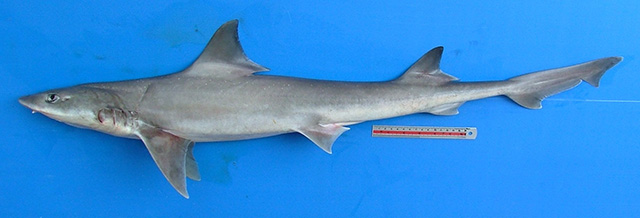| Triakidae (Houndsharks), subfamily: Triakinae |
| 128.3 cm TL (male/unsexed); 103.4 cm TL (female) |
|
benthopelagic; marine; depth range 69 - 735 m |
| Eastern Indian Ocean: tropical, from northwest Australia to southern Indonesia and the Andaman Sea. |
|
This moderately large species is disinguished by the following characters: palatine processes of the
palatoquadrates not subdivided at the symphysis; pre-second dorsal length 58.1-61.4% TL; upper labial furrows are longer than lower furrows, upper ones 1.7-2.3% TL and 1.3-1.7 times lowers; buccopharyngeal denticles cover entire tongue and roof of mouth; reproductive mode aplacental viviparity; adults are without any hypercalcification of skeletal elements; dorsal fins moderately large and upright, first dorsal-fin anterior margin 13.0-15.7% TL, height 8.5-10.3% TL; claspers of adults are moderately long, inner length 8.1-11.2% TL; teeth in about 72/75 files; precaudal vertebral centra 75-91, monospondylous centra 33-41; small white spots usually present on the dorsal surfaces of body, including along lateral line; dorsal fins often with dark apical margins; caudal-fin terminal lobe white tipped (Ref. 124465). |
| Recorded litter size litter sizes of 5-17 pups with size at birth likely to be around 28.0 cm TL (Ref. 124465). |
|
Least Concern (LC); Date assessed: 02 August 2018 Ref. (130435)
|
| harmless |
Source and more info: www.fishbase.org. For personal, classroom, and other internal use only. Not for publication.
